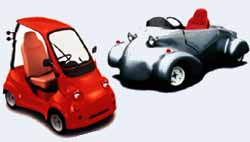|
Top Picks || Arts & Entertainment || Business & Economy || Education & Society ||
LET'S TAKE A LITTLE DRIVE: Mitsuoka Hits the Road with Do-It-Yourself Cars October 30, 1998  The K-1 (left) and K-2 single-seaters are gaining fans among both hobbyists and motorists. (Mitsuoka Motor Co.) Mitsuoka Motor Co., based in Toyama Prefecture, has been making the headlines recently after putting do-it-yourself kits for 50-cc cars on the market. It is the first time for a car requiring users themselves to assemble the parts to go on sale in Japan, and the first kit in the world to include the engine among the parts to be assembled. Good to Make, Admire, and Drive Mitsuoka, the kit car's developer, is an automaker with annual sales of 33 billion yen (275 million U.S. dollars at 120 yen to the dollar) and a work force of 380 employees. Since its establishment in 1968, the company has mainly manufactured cars inspired by classic automobiles. Now Mitsuoka has begun selling its kit cars, with prices ranging from 320,000 to 580,000 yen (2,670 to 4,830 dollars). The buyer can select the enclosed K-1 or the convertible K-2, and choose from options including painted or unpainted bodies and preinstalled or uninstalled engines. Similar do-it-yourself trucks and wagons are scheduled to hit the market in March 1999. Since the assembled car is classified as a motor-driven cycle under the Road Transportation Vehicle Law, the inspections normal cars must undergo are not required. But because it takes up a full lane when driven on the road, it is treated as an ordinary automobile, so a driver's license for ordinary cars is necessary. Although the assembled car cannot be taken on expressways, owners can still take delight in driving a car that they have assembled themselves on the open road. Getting More Kit Cars on the Road Although the kit car is essentially a niche product, sales are going well: The company reported about 500 units sold as of the end of August 1998. At present it is sold only at 10 Mitsuoka outlets, but the company plans to make it more widely available in the future through motorbike stores, gas stations, and do-it-yourself shops. So the day may not be too far off when people can go out and purchase assembly-type car kits just for their weekend hobby. According to a spokesperson at Mitsuoka, "By bringing parents and their children together to assemble their own cars, we hope to give a boost to parent-child conversation, which has declined recently."
 Edited by Japan Echo Inc. based on domestic Japanese news sources. Articles presented here are offered for reference purposes and do not necessarily represent the policy or views of the Japanese Government. Edited by Japan Echo Inc. based on domestic Japanese news sources. Articles presented here are offered for reference purposes and do not necessarily represent the policy or views of the Japanese Government.
|
